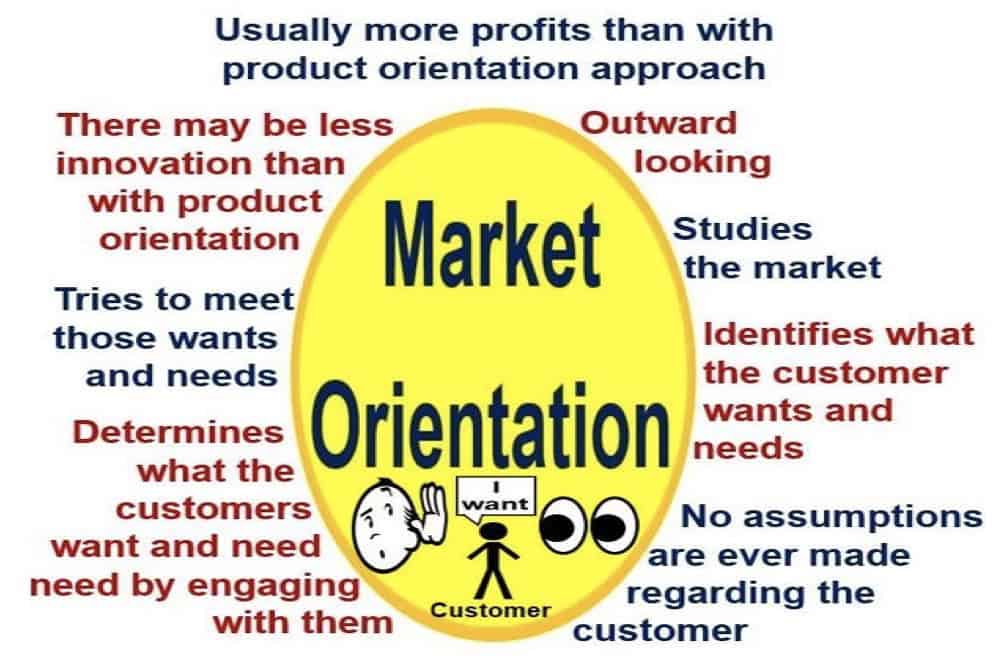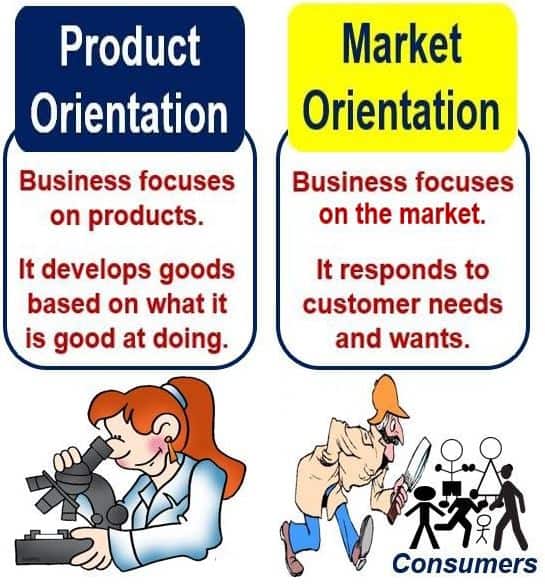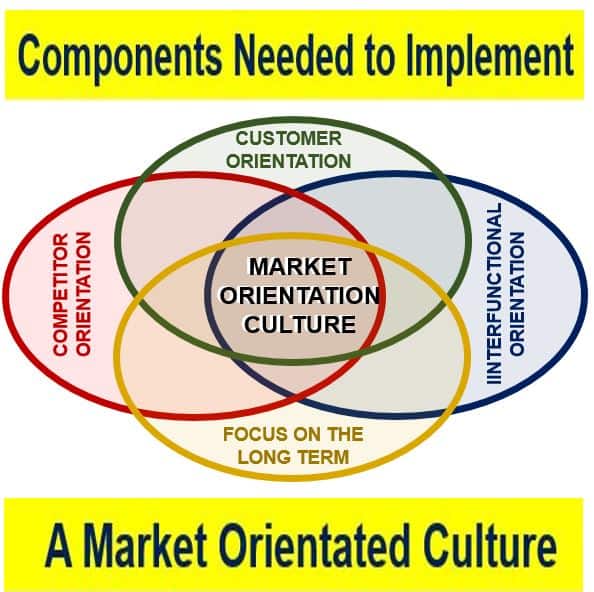What is market orientation? Definition and meaning
Market Orientation is a business philosophy where the focus is on identifying customer needs or wants and meeting them. When a company has a market orientation approach, it focuses on designing and selling goods and services that satisfy customer needs in order to be profitable. Successful market-oriented companies discover and meet the desires and needs of their customers through their product mix.
Understanding and adapting to customer behavior is the cornerstone of market orientation, guiding companies to prioritize consumer needs in their strategic planning.
Meeting customer demands
Market orientation works in the opposite direction to past marketing strategies – product orientation – where the focus is on establishing selling points for existing goods. Rather than trying to get your customers to like or become aware of the benefits of your products or services, with the marketing orientation approach you tailor them to meet the demands of customers.
Many marketing gurus define market orientation as a coordinated marketing campaign between a supplier and its buyers.
The main disadvantage of a market orientation approach is the lack of innovation. If you spend all your time satisfying customer needs, you may lose sight of what potential technical breakthroughs there might be. Product-oriented companies, on the other hand, tend to be more technically or scientifically innovative, but lose out because they have less knowledge about what the consumer wants.
Social Fish defines market orientation as follows:
“A business philosophy that focuses on identifying customer wants or needs and then meeting them.”
In a recent interview, Marketing Strategist and Keynote Speaker True Tamplin said this about market orientation:
“Market orientation is absolutely essential in today’s saturated world. Focusing on the customers’ needs and creating organic brand loyalty is the foundation for lasting, consistent growth.”

Market orientation – a culture
Market orientation is more of a culture than an individual process. It is the mindsets, values, beliefs, norms and behaviors of companies, together with the systems, structure and control of the organization.
Market oriented commercial enterprises define their activities as service activities aimed at satisfying their customers. What drives them are customer needs – they are listed as their main objective.

-
What about Apple Inc.?
If a product-oriented company focuses more on its product than the market, and a market-oriented one concentrates more on the market and what customers want, what type of business is smartphone and computer maker Apple Inc.? Doesn’t it focus on both?
A company that follows the market orientation approach reacts to what consumers want. Most of the decisions it makes are based around data related to consumer requirements, not what the organization believes is right for them.
The majority of highly-successful companies today are market oriented. A surprisingly high proportion of businesses that went to the wall focused more on their products than consumers.
Additionally, market-oriented companies invest heavily in consumer research to anticipate market trends and adapt their strategies proactively.
-
Customers today
Since the advent of the Internet, the customer knows much more about the market, what products are out there, what to expect – and he or she demands better quality and more variety.
For example, if I want to buy a car within the $15,000 to $20,000 range, I can go online and within 30 minutes have detailed information that before the Internet existed would have taken me at least a couple of days to acquire.
In order to survive in the marketplace, companies must be more sensitive to the needs and demands of customers. If they are not, and their competitors are, those businesses are doomed.
-
The market has changed
Gone are the days in the automobile market, for example, when manufacturers could create a new product and promote its features to a gleeful public.
We now live in a global economy, where consumers have a virtually limitless range of choice. In order to remain competitive, companies must follow the market orientation approach religiously.

Market orientation vs. product orientation
In the world of business, companies can develop new products and services based on either the product orientated or market orientated approach.
With a product oriented approach, the company develops goods and services based on what it does well, rather than what the consumer wants.
-
Product orientation approach is risky
This is risky, because if you make something new, regardless of how good you are at creating it, what happens if the customer does not want or need it?
A product oriented company makes unsuccessful products significantly more frequently than a market oriented business, which reacts to what customers want.
In an article titled – Market Orientation – published by the Wiley International Encyclopedia of Marketing, Stanley F. Slater, Jakki J. Mohr, and Sanjit Sengupta wrote:
“In essence, market-oriented businesses generate intelligence about customers, competitors, and other key influencers; share that intelligence broadly throughout the company; integrate and achieve a shared interpretation of the meaning of the market intelligence; and take coordinated action based on that shared interpretation.”
“A large body of research has shown that market-oriented businesses achieve superior new-product success, sales growth, and profitability.”
-
The change requires a total commitment
Becoming a market oriented company is no easy task. Sometimes it means completely transforming the way the business is organized – from head to toe. In order to be able to do this successfully, the top management needs to be fully committed.
The 4 stages to market orientation
According to a study carried out by Gary F. Gebhardt, Gregory Carpenter and John F Sherry Jr. – Market Orientation: The Construct, Research Propositions, and Managerial Implications – and published in the Journal of Marketing, there are four stages to creating a market orientation: 1. Initiation. 2. Reconstitution. 3. Institutionalization. 4. Maintenance.
-
Initiation
In this stage, executives and other important stakeholders first identify an external threat to the business, such as failing to meet its financial performance targets. They then identify specific initiatives that need to be implemented as part of the transformation process.
In their study, which examined seven companies that were just starting to adopt greater market orientation, the authors identified one business that had been losing millions of dollars in revenue. Senior management responded by outlining a new set of values expected of all employees – respect for others, empathy, collaboration, etc. – and listed process-focused change initiatives, including information technology, continuous improvement, and communication systems.
-
Reconstitution
The plan is presented to all employees simultaneously. It must include a description of the values that have been identified and adopted to guide the company’s behavior, as well as the specific changes that are going to take place.
Following the presentation of the plan to the entire organization, the company can explain to everybody how cultural values affect its ability to meet the needs of the market by sending teams of people from different departments and functions to meet with key stakeholders, including customers.
Employees who are not willing to embrace this new culture need to be replaced with individuals who are. As soon as every single employee agrees on a definition of the market, and which of its needs remain unmet, all can collaborate to develop a strategy to meet those needs.
-
Institutionalization
Only when a market-oriented culture is fully incorporated within the company, has it reached this stage.
Employees are rewarded as the business’ performance in the marketplace improves. Cultural values are reinforced with seminars and other training programs. All members of the company become involved in its decision-making process.
The number of ideas for resolving problems and challenges is much greater if everybody has the opportunity to contribute, rather than just the top management – the company is more likely to find an effective solution.
-
Maintenance
The aim here is to prevent any deterioration in the organization’s market orientation approach.
Job applicants are carefully screened to make sure they fit the restructured image, workers become involved in activities that remind them of the company’s process of cultural change.
Employees from different departments are involved in field visits and research.
An article published by KellogInsight – Walking the Walk – which commented on the study, made the following observation regarding the ‘maintenance’ stage:
“To promote a culture of ‘Harleyness,’ Harley-Davidson evaluates prospective employees on their level of cultural fit and encourages employees to own and use motorcycles; its executives attend rallies to keep in touch with customers.”
“Maintenance requires firms to accept new policies and strategies only when they are consistent with core values.”
A market-oriented framework necessitates continuous innovation to stay aligned with the evolving preferences and expectations of consumers.
Two Videos
These two educational videos come from our sister channel on YouTube – Marketing Business Network. Using easy-to-understand vocabulary and examples, they explain what “Market Orientation” and “Client Centric” mean.
-
What is Market Orientation?
-
What is Client Centric?

